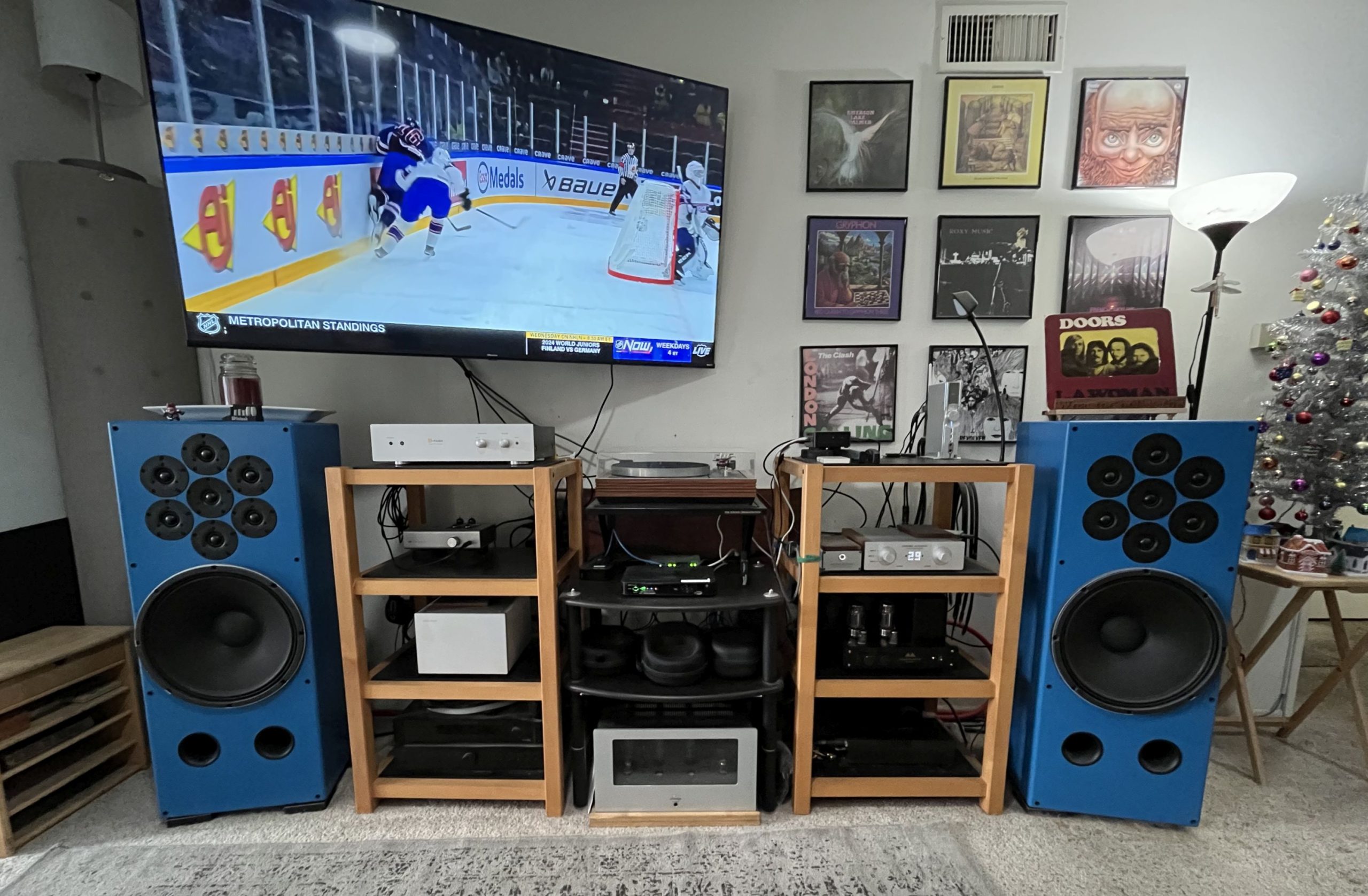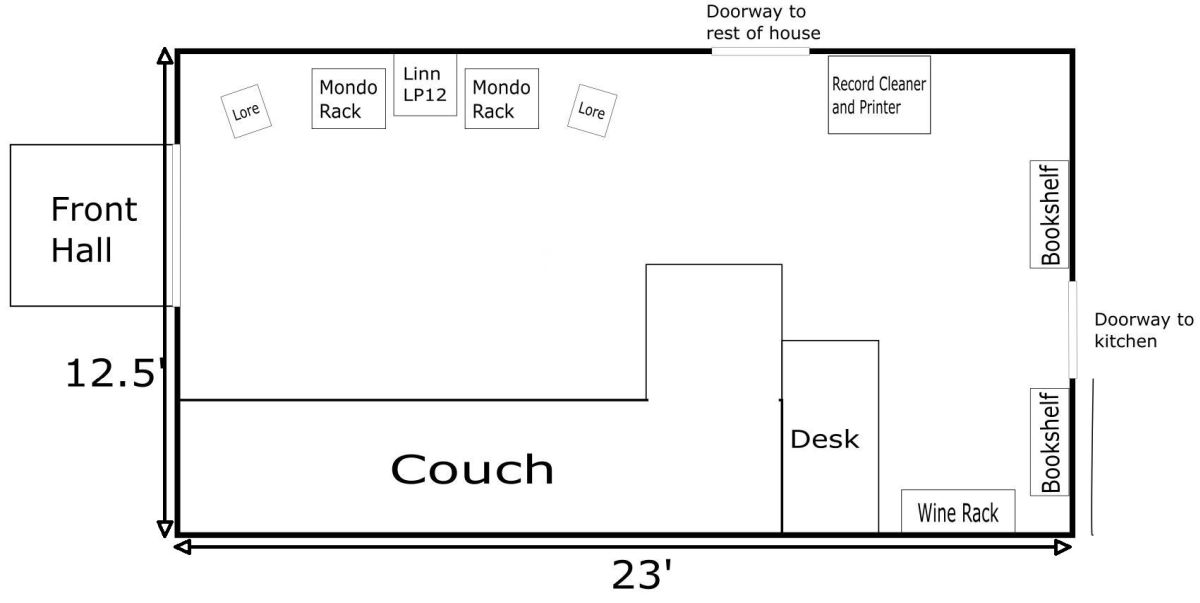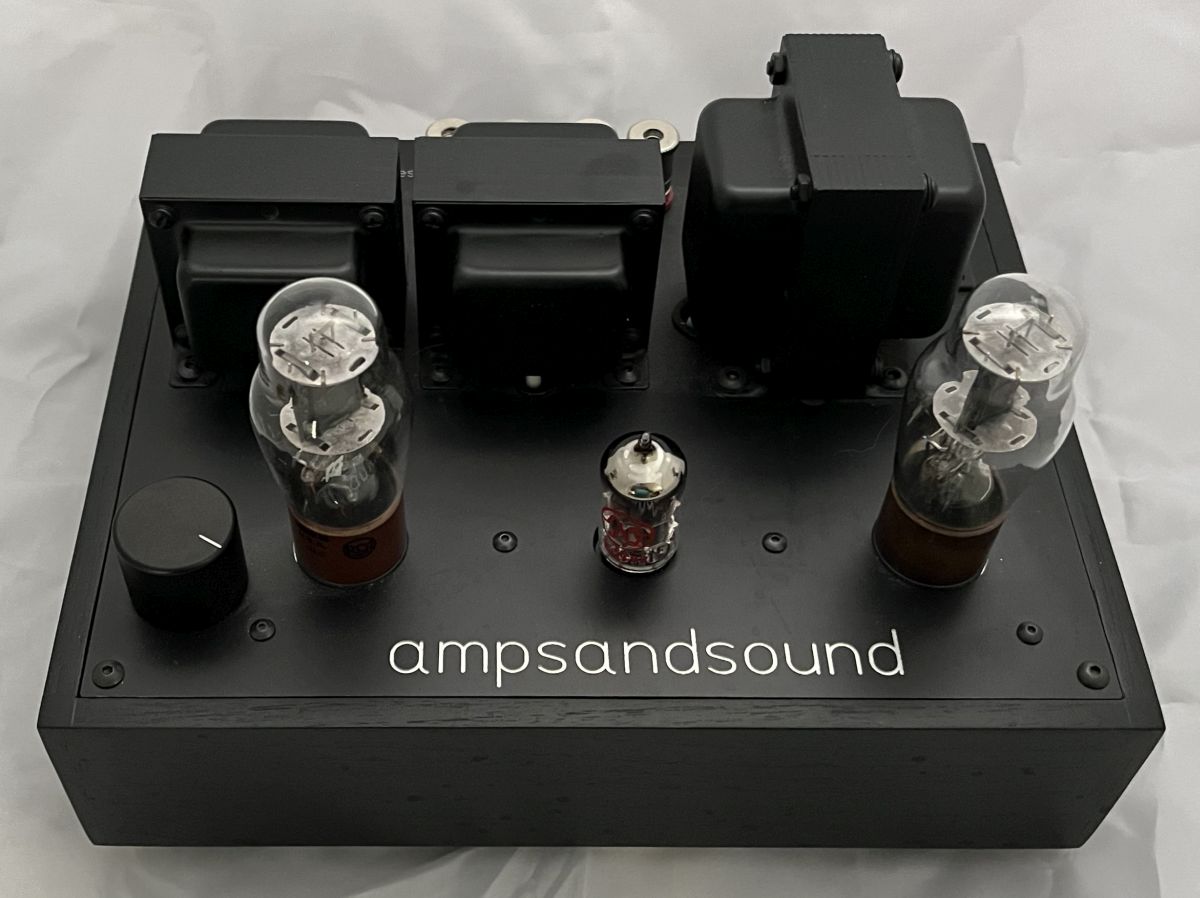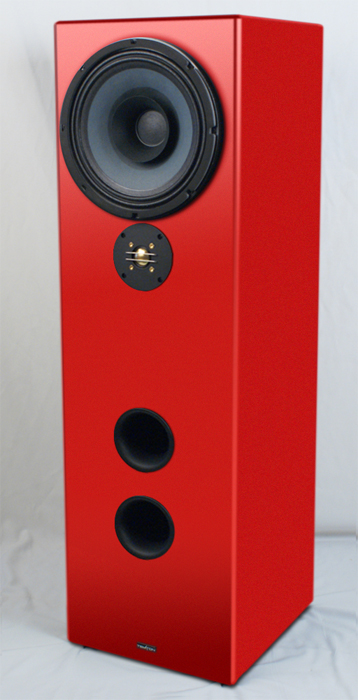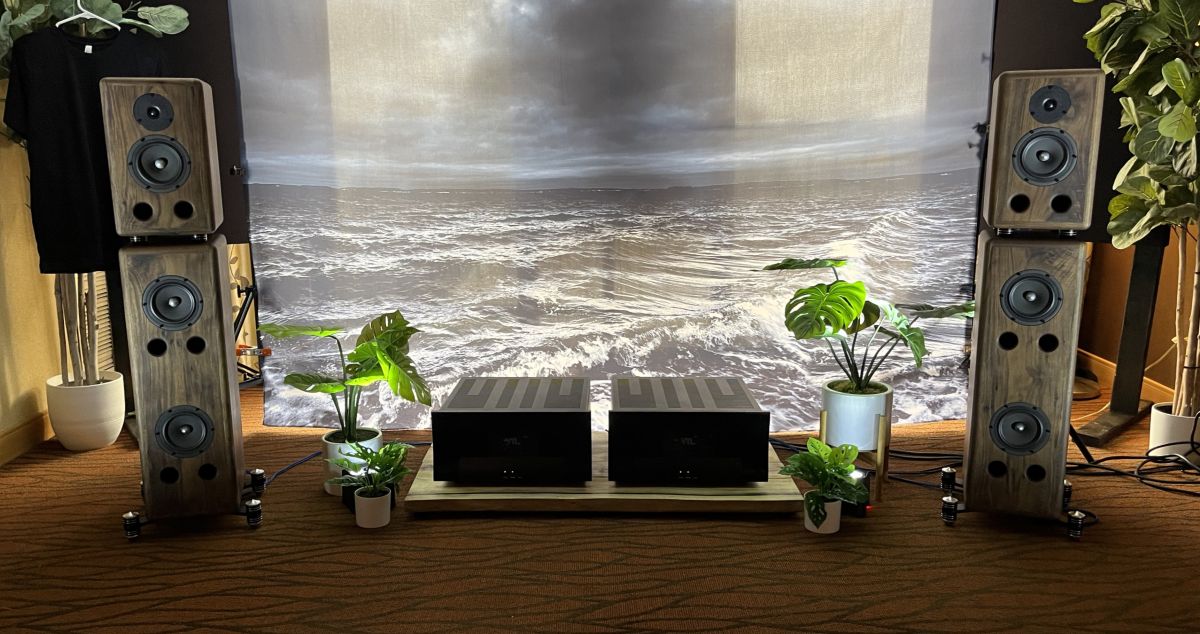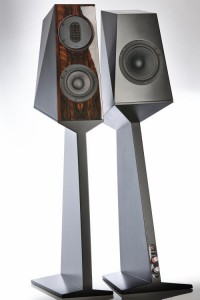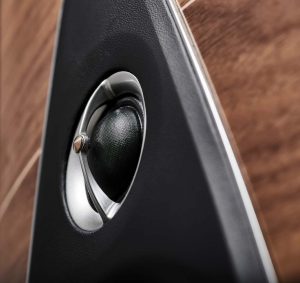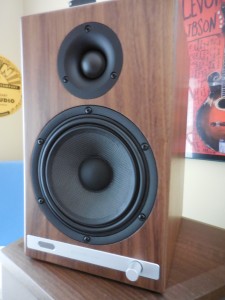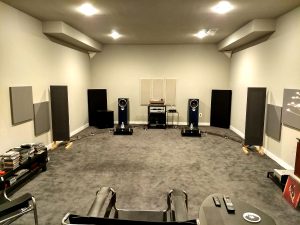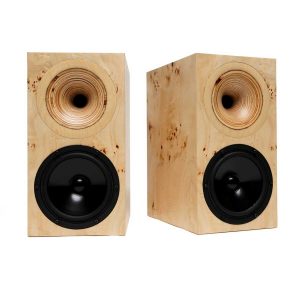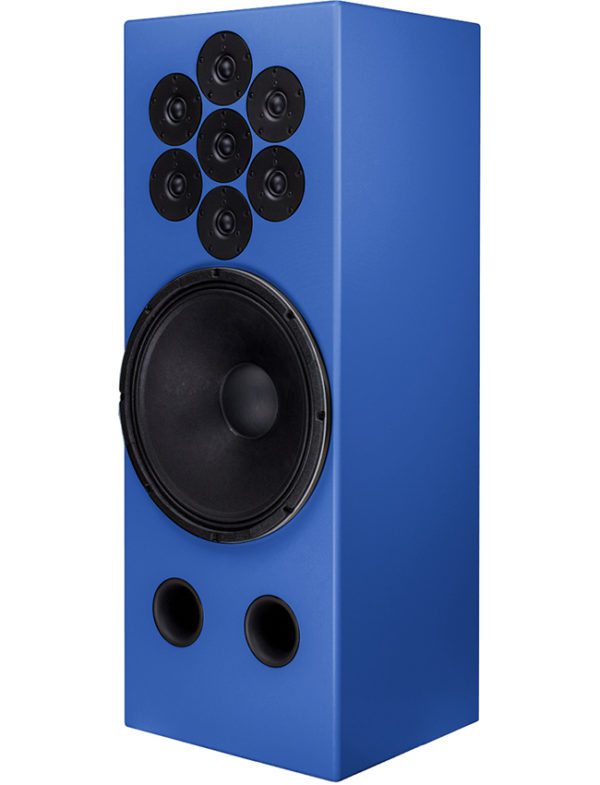
This review has had probably the longest gestation period of any review I've ever done. I've had the Tekton Perfect SET 15 loudspeakers in my possession for three years already. In fact, I already gave them a Writer's Choice award in 2021. Why the long wait? As explained in previous articles, much of the first year was lost to the impact and aftereffects of a severe case of Covid-19. For months after I technically "recovered" from Covid, listening at anything above very quiet levels was painful, and any harshness or exaggerated high frequencies made my head ring like a bell.
Once those aftereffects faded away, I was left with a constant nagging feeling that as much as I liked the sound I was getting, I simply knew there was better to be had, and I was not approaching the limits of what the P-SET 15 could deliver. So I went in search of other amplifiers and anything else I could try to see what I could coax from these fairly unassuming speakers. When they were new and I wanted to give them a thorough break-in period, I used my 100-watt Burson Timekeeper Virtuoso amplifier, a beautiful sounding solid-state amp that works well with pretty much every speaker I have. This way I could let it run twenty-four hours per day, keeping a low signal playing through the speakers all night long. This was all during my post Covid period, so I can't say how many hours it took, but by the time I could actually listen attentively and at my normal loudness levels, the speakers had probably 300 hours on them.
But before we get into any of the other stuff, why, when I already have both Tekton's Lores (original review HERE) and Double Impacts (original review HERE), would I want to try another model? Why wasn't I still using the Double impacts? Good questions.
On the Tekton Owner's Facebook group, there seems to be a running theme of getting the biggest model you can afford, without much concern for the room they will go in. I've seen people posting about having really large models, like the Moab, in small 10' x 12' bedrooms. That doesn't make sense to me. The deeper and more prominent the bass response of a speaker, the more critical placement in the room becomes and very often, the greater the distance from the wall behind will be needed. Bass nulls and nodes are real and need to be dealt with via placement and acoustical treatment. You can't equalize or DSP your way out of a room null.
That was the issue with the Double Impacts in my room. Where the Lores sounded wonderful and had very satisfactory bass down into the mid 30Hz range in my room, I simply was never able to get the Double Impact to sound right in my room (click on my name at the top and there is a description of my room). If I got them positioned for optimum deep bass, mid-bass lost all its energy and bass guitar had no impact. If I got them positioned for better response in the 80 to 120Hz range, then there was lumpy ill-defined and limited low bass. It wasn't the speakers, as when I loaned them to my friend Russ Stratton, in his much larger room, bass response was smooth, coherent and extended. It was just not something achievable in my room.
In fact, when I borrowed the Impact Monitors that Victor Chavira reviewed for PF (Victor's review HERE), I was slightly surprised but understood that by fitting better and coupling to my room more effectively, they were overall more enjoyable than the Double Impact in my environment. It was also the clarity and detail improvements of the Impact Monitor over the Lore that kept me thinking I needed to find a model in their lineup that used the tweeter-as-midrange array, and that offered solid bass that would fit my room better. But picking a model in the Tekton lineup isn't always easy, as they offer so many models, several of which fall within similar price points.
I always say I am technology-agnostic and don't really care what is inside the gear I use, whether it be solid-state vs tube, analog vs digital, box speaker vs planar, or any other technological points of contention, I just like what works best for me in my system in my room. Whether I use tubes or solid-state is largely based on what speakers I'm using. When we set up our Magneplanar .7 or ELAC F5 we use a beefy 100 -watt solid-state amplifier. With the Tektons we tend to go with lower powered tube amps or moderately powered (about 50-watt) solid-state amps.
But then Tekton came out with the Perfect SET series. Where most Tekton speakers are specified as 4-ohm loads, these were all 8-ohm nominal rated speakers with sensitivity spec'd at 98dB or better, and claimed to be optimized for low powered tube amps. The original three models in the lineup were explained in a video on the Tekton web site as optimized for certain power levels. The P-SET 15 reviewed here for amps from 1- to 8-watts, the P-SET 12 for amps from 8- to about 20-watts, and the P-SET 2-10 for amps more powerful than that. But what the video seemed to stress wasn't the actual power of the amp, but the intended loudness levels the listener intended to play. I called Eric Alexander and discussed this with him, and that in fact turned out to be it. Whereas all Tekton speakers can handle large amounts of power (even the P-SET 15 is rated at 300-watts power handling) and can all play extremely loud without strain, the P-SET line is one where actual playback levels are taken into consideration.
For me, the P-SET 15 ($2190/pair) being optimized for average playback loudness in the mid 80dB range with peaks into the mid-90s, fits almost perfectly with my normal listening habits and preferences. I live in a townhome with shared walls, so cranking tunes at 100dB isn't very neighborly. However, as long as I've been involved in this, the past 50 years or so, that has actually been my normal listening level. I simply am not comfortable in front of a system playing at 100dB or more for any length of time. I'm the guy at audio shows always asking exhibitors to turn it down. I'm also a guy who has always worn ear protection at amplified concerts, when mowing the lawn or simply doing anything that maintained excessively loud conditions.
What that optimization means is that the 15" Eminence bass driver can extend to the low 30Hz range and actually move some air without having to play too loudly. The upside is that if you know your normal or preferred listening level, you have choices for low powered tube amp friendly speakers to match. The downside, is if you exceed the optimization range, the sound doesn't fully hold up. Potentially, the bass might not retain its coherency and or have the seamless blend in the transition to the midrange array. I'll have a lot more to say about this later.
But the reason to listen to a Tekton speaker is their patented tweeter array. I see on various internet groups and discussions a lot of people still don't understand the design. In a "single array" speaker like the Double Impacts, Impact Monitors, or the P-SET series, the six outer tweeters are used together as a midrange driver, playing much lower than you would expect, and then also rolled off at the crossover point to the center tweeter. That center tweeter is the only one used to cover higher frequencies. This ultimately acts as a single concentric midrange/tweeter unit with the inherent point-source radiation pattern and potential for superb imaging that concentric driver setups are known for. In the larger "double array" speakers like the Moab, Encore, and Ulfberht, all seven tweeters of each array are used as a single midrange driver. Once again, only the one single tweeter between the two arrays handles higher frequencies. This acts more like a conventional MTM array.
When ordering most Tekton speakers you have some upgrade choices to make. For the P-SET 15, you get to pick color; seven standard colors at no extra charge, or for $50 extra you can designate any paint from Behr, Benjamin Moore, Sherwin Williams, or Valspar. My review set came in standard blue paint and looked nice enough. I'd say the fit and finish have been improved substantially in the twelve years since I first received my Lores, though they don't have that luxury visual appeal some other companies can offer in a similar price range. One can comfort themselves by thinking Tekton put the money into the sound rather than the cosmetics if that makes them feel better. Personally, my wife and I are fine with the how they look.
You also get to pick whether or not you want the "upgrade package" which for $310 gets you "solid billet copper Cardas inputs (USA), mil-spec internal wiring, Mundorf or ClarityCap (depending upon real-time availability) within the tweeter section, and an oversized Jantzen or Erse Sledgehammer inductor (depending upon real-time availability) within the woofer section." Then pick whether you want grilles ($80) or not, which I requested for the review pair to protect the drivers from our three dogs. Next, make your choice of spiked or hardwood-floor footers. Mine came with the flat hardwood-floor feet. You also get to pick speaker connections for either single (standard) or optional bi-amp or bi-wire which cost an additional $75. I chose not to get either of these options.
One important point about the footers. If you choose not to use any footers, maybe because you will use some other isolation device under the speakers, you need to either get ¼-20 bolts to screw into the footer inserts or find some way to seal the inserts. They extend all the way into the cabinet, and if they aren't sealed they become very noticeable either as an upper midrange distortion or in some cases, an actual whistling sound noticeable at certain frequencies. I made that mistake when I borrowed the Impact Monitors and had them sitting on Audioquest Q-Feet! It took a while to figure out the issue.
One option not offered directly on the P-SET series that most other Tekton models can get is to upgrade to a beryllium tweeter to replace the one center tweeter. Again, on the Tekton owner's group it is generally recommended, and it seems a lot of people there have gone for it. If it had been available for the P-SET 15 I would have skipped it though. Not because of the $400 or so additional cost, but because one thing I find exceptional with the Tekton speakers I've tried is the superb coherency in the transition from midrange to the tweeter. You really can't tell where the transition is, and since the characteristics for the midrange array and the center tweeter in standard configuration are obviously the same (being all the same drivers) I simply wouldn't want to risk altering that. From the description of the impact of upgrading the tweeter from those who have done it, it always seems like it has become noticeable. This makes me think maybe it has become less coherent. I may be wrong about that, and take it with a grain or two of salt, as I've never heard a Tekton with the Be tweeter upgrade, so probably shouldn't speculate on it.
I should mention the physical size of the speakers. Some people might think of them as large speakers, but I've had so many medium to large speakers in my room over the years that the P-SET 15 at 41.5" tall x 16" wide x 14" deep seemed pretty average to me. At 87 lbs. each they were fairly easy to unbox and move into position. The grill covers are substantial at a full one-inch thick with an MDF frame and weight just over 3.5 lbs. each. They are full height, covering the entire front of the speaker. They attach with standard plastic pins and inserts. Personally, I would prefer them to be shorter and only extend to the bottom the woofer, leaving the two large front ports visible. Magnetic attachment would be nice too.
So after all that, after I was sufficiently recovered from my bout with Covid and able to comfortably listen and evaluate, I ran into some issues. For starters, positioning the speakers was not only extremely critical, but also seemed to be amplifier dependent. Initially, I simply could not get a smooth, coherent transition from the bass to the rest of the sound. It wasn't a loudness or EQ issue, but the general characteristic of the bass, which seemed slow and loose and just didn't match the speed and clarity of the midrange array. I understood the frequency issues due to positioning from the wall, and found a spot that optimized overall sound with a slight dip at about 63Hz and a small peak at about 88Hz, but the blend of bass to the rest of the sound eluded me. Surprisingly it was worse with the Burson Timekeeper or Schiit Vidar solid-state amps than it was with the single-ended tube Antique Sound Labs amp I planned on using.
Swapping the standard feet for spiked feet made it worse. It really seemed to put focus on the different characteristics of the large woofer and super-fast midrange array. Ditching the feet altogether and (after blocking the threaded inserts) just setting the speakers on the carpeted floor improved things enough to make them enjoyable to listen to, but I was sure there was still better to be had. After months of trying to remedy this, I contacted Norman Varney of AV RoomService and asked about trying a set of his EVP isolation pads.
I've long known that isolating speakers from the floor is usually better than coupling speakers to the floor, and have long used either Bright Star IsoNodes or Audioquest Q-Feet to isolate smaller speakers from their stands, but I simply didn't have anything for the 87 lbs. weight of the P-SET 15 speakers. Norman sent me a set of eight Large High Density EVPs, four for each speaker. I'll have more to say about EVPs in a separate article later, or you can read Tom Gibb's excellent review of them HERE. At $1592 for the eight EVPs I received they are fairly expensive relative to the kind of products I normally review, but the immediate and positive impact they had on the sound was indisputable. The clarity, purity, and speed of the bass was greatly improved and most importantly, the blend to the midrange and the coherency of the overall sound was vastly improved, enough so that I finally felt I could legitimately evaluate the sound of these speakers. This isn't to say that other isolation footers, from IsoAcoustics, Townshend and others won't also be very effective, just that I haven't tried them in my system yet. I have heard very convincing demos of those (and others) that proved their worth and effectiveness too. A lower cost option popular on the Tekton owners group is the quite inexpensive (around $40 on Amazon) Nobsound Spring Feet though I have not had the opportunity to try them yet.
Then the next big change to my system that really helped with the sound I was getting through these speakers was the arrival of the Khozmo Passive Preamp that has found a forever home in my system. The improvement in transparency and clarity the Khozmo brought to the system further showed that I hadn't reached the limits of what the P-SET15 could do. You can read my review of the Khozmo HERE.
Then as if there weren't enough delays, my trusty Antique Sound Labs MG-SI15DT-S amplifier that I expected to use as my primary amp in this review, and that has been a mainstay in my system for well over twenty years, went up in a puff of smoke. It sat for a couple months while I used a variety of other amplifiers before it headed off to George Meyer AV in Los Angeles for an overhaul and repair. New capacitors, tube sockets, and a fresh set of tubes not only restored its near magical sound, but had it sounding better than ever.
So, now, let's get on with how this speaker actually sounds. Please understand that over the time of the review evaluation, I used several amplifiers, including but not limited to:
- Burson Timekeeper Virtuoso (100-watt solid-state)
- Schiit Vidar (original version, 100-watt solid-state)
- Antique Sound Labs MG-SI15DT-S (15-watt, KT88 single-ended pentode, my primary amp for over 20 years)
- Quicksilver Audio 8417 mono blocks (40-watt, Push-Pull, factory upgraded to run EL34 tubes)
- Almarro A205 (5-watt, single-ended, EL84)
- Emotiva TA-100 (integrated 50-watt, A/B solid-state)
- ampsandsound Kenzie Integrated (SET using a single 1626 triode per channel, 1-watt, yes, one watt!)
I used either Vermouth Audio Red Velvet or Audioquest Type 5 speaker cables, alternating as I saw fit.
Due to all the aforementioned delays and use for TV and background music, the speakers had a few hundred hours on them before I really got down to evaluating them. I started with my Antique Sound Labs amp in the system. All comments from here on out will be with the speakers on the EVP isolators, unless otherwise noted.
Where to start? Maybe Goldilocks was on to something. No, not the breaking and entering or rummaging through the bears stuff or eating their food, but the idea that sometimes things can be too much, not enough, or just right. As mentioned already, the Double Impact was too much for my room and I was never able to get them to sound their best. Either I couldn't get them far enough from the wall or I couldn't sit far enough away, or just maybe the general layout and size of my room didn't work with them. They sounded good, but not as good as I knew they were capable of from hearing them in few other, better suited rooms. Great speakers elsewhere, but they weren't going to work out for me in the long run.
The Lore on the other hand, sounded wonderful in my room. Vibrant, exciting, articulate and with enough bass to be enjoyable on whatever music I wanted to play. They were my primary speaker for almost 10 years. They were, and continue to be a real music lover's speaker, and remain my first choice for speakers in the approximately $1000 per pair price point. However, in direct comparison to the Double Impact and Impact Monitors, the Lores did show that the single 10" near-full-range driver was limited in detail and ultimate clarity and transparency. This did make them exceptionally good with a lot of the less than audiophile quality LPs and files in my collection, which has always been an important point to me when evaluating any speaker or other component. They have to be able to play whatever I want to listen to, and the Lores did that better than most speakers I've tried over the years.
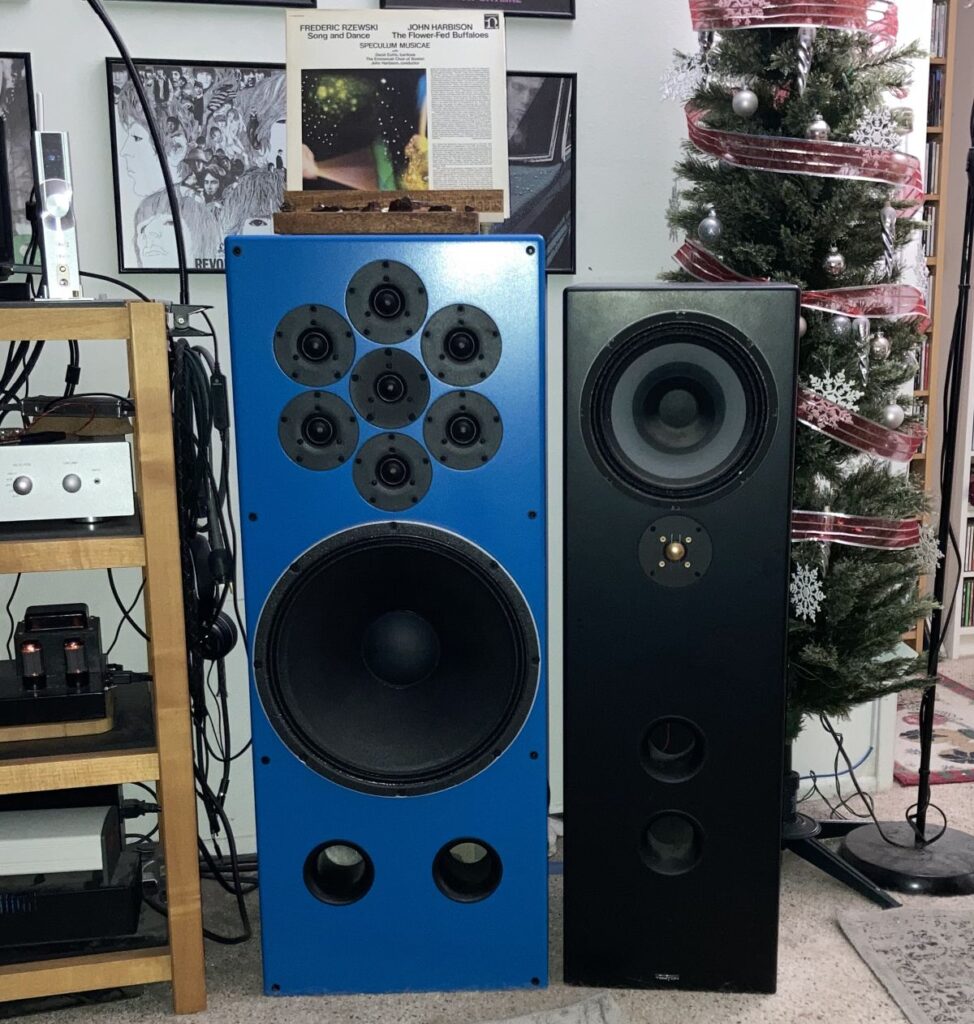
Perfect SET 15 without EVPs and Lore. Photo by Steve Lefkowicz
The P-SET15 seemed to fall into a happy area of just right in my room. Right off the bat, they were clearly and substantially more detailed through the midrange than the Lores, and rivaled or surpassed the best I've heard in my system over the years. In that regard, they were on par with the ribbon midrange drivers of my old VMPS RM-2neo, and though seemingly very different, they equaled or possibly surpassed the midrange detail of our Magneplanar .7 and their quazi-ribbon panels. And, maybe due to the particular tweeters used for the midrange array or the easier to drive 8-ohm load, they seemed more detailed and played with greater clarity than either the Double Impact or the Impact Monitor, as I remember them. It was really interesting hear so much clarity so deep into a recording. Picking out individual instruments or musical lines was very easy, not necessarily due to spatial queues, but simply by having any difference in their sound so clearly played.
One thing I've heard from every Tekton speaker I've tried is that the P-SET15 really excels at is dynamics. Regardless of how much or how little power they were fed (yes, even with the one-watt Kenzie amp) these were exceptionally dynamic. What was really special was how expressive and exciting their dynamic capabilities were at the moderate listening levels I enjoy. Though the Lores come close, no other speakers I've tried over the years could be quite so nuanced dynamically when listening in the low to mid 80 dB range. I listen to a lot of Americana and folk, and much of that genre is quiet, gentle, and expresses feeling and emotion through subtle variations in dynamic shadings. The P-SET15 really excels at reproducing that with its combination of speed, clarity, and dynamic ability. But when there are large dynamic contrasts, the kind that make you jump, these are like cannon shots into your room. If a recording has really good dynamic range and doesn't limit it through overaggressive dynamic compression, the P-SET15 will let you hear it.
Unfortunately, the downside to this is that overdone dynamic compression in a lot of pop and rock recordings is exposed and becomes more noticeable. This is not to the point that I don't want to listen to them if it is music I really like, but it is as close as I care to get to those audiophile speakers that make better recordings sound great and poor recording sound outright bad. The lack of dynamics in some pop tunes make them come across as flat and dull, more so than with most of my other speakers.
Overall tone and midrange neutrality is very good with these speakers, though also very amplifier dependent. Tube amps with EL34 and EL84 tubes are often known for their midrange beauty, and with both the Almarro A205 (EL84) and the Quicksilver 8417 (running EL34 tubes) this was certainly the case. Midrange tone was simply to die for, being full, whole and rich with a depth that just helped you forget all the other distractions in your life. The tradeoff though, was bass that lost a little impact and energy. Bass, especially near the lower limits of the speaker's capabilities, was tuneful and smooth, but just not as powerful and precise as it was with other amps.
Using my Antique Sound Labs amp with its single KT88 tube per channel, or putting match set of KT88s in the Quicksilvers (plenty of adjustment available to set bias for them) traded off a slight bit of midrange beauty for a much more powerful and detailed bass response. Not to say the midrange tone and presentation wasn't still excellent, and it certainly was finely done to my ear, but it just lost that little bit of seductive, hard to describe in objective terms, beauty. Over the years with a lot of speakers I've tried, I've found that difference between EL84, EL34, and KT88 amps to be consistent.
The two solid-state amps, both the Burson and the first generation Schiit, sounded fine, and if someone had no reference points with other amps, would probably say they sounded great. They both did sound very good with the P-SET15, yet neither did anything better than the tube amps with these speakers. The extra power they offered was probably never a factor. I doubt in all my listening if I ever used more than one or two watts. Though these two amps have very similar specifications the P-SET15 was still able to clearly show differences in how they sounded. The original Vidar has always been an easy recommendation for anyone looking to spend under $1000 for a high powered amp, and the Burson Timekeeper Virtuoso has been one of favorite amps with almost every speaker I've tried it with. Through the P-SET15 the Burson was clearly more transparent, subtly, though noticeably more dynamic, more tonally complete and just better at almost everything when listened to in direct comparison to the Vidar. Considering its original $3000 price tag one might expect that, but we all know price isn't always an indication of sound quality. Still, both of these amps lacked the physical, three-dimensional soundstage that all the tube amps offered, and simply couldn't match their midrange tonality and beauty.
The outlier here that will be described in greater detail in its own review very soon, was the ampsandsound Kenzie Integrated. This is the lowest cost amp in ampsandsound's ever growing array of amplifiers, though at $2900 it still is not cheap, especially considering its 1-watt output into an 8-ohm load. I only tried it because ampsandsound's Justin Weber simply asked if I wanted to try it after I described the P-SET15 to him. Tekton does specify a 1-watt minimum for these speakers so I figured I should try it.
First off, at my normal listening levels, again, low to mid 80s with peaks into the mid 90s dB range, and which is actually louder than many people would imagine, one watt proved to be plenty. At no time did I hear any strain, clipping or distortion. Secondly, the 1626 triode tube proved its worth as a low cost alternative to exotic and expensive triodes, finding NOS tubes plentiful on the internet from reputable sources and ranging in price from about $15 to $35. I used the amp with the volume all the way up and fed from my passive Khozmo preamp. I did however swap the single JJ ECC82 (12AT7) driver tube for a JJ ECC803s (long plate 12AX7) to increase the gain. That allowed for better match to the passive preamp and to reach normal listening levels.
This combo was pure magic. Midrange tone matched or exceeded the EL84 or EL34 tubes, bass response that bettered the KT88 amps, soundstage creation that was wider and deeper than any amp I've tried with these speakers. The combination of the Khozmo preamp, Kenzie Integrated as power amp and P-SET15 speakers had me entranced every time I sat to listen. Speakers and amps should always be considered as "matched pairs" and this simply has been the best pairing of any I've tried so far.
Some other aspects of the bass response of these speakers need some discussion. The low end doesn't extend too much farther down in frequency than the Lores (low 30Hz for the P-SET15 vs mid-to-low 30Hz for the Lores), but does so with a substantial improvement in tactile feel. Kick drums hit you, bass instruments, especially plucked and slapped bass guitar, has real impact that you can feel. At my normal listening levels bass response is probably the most satisfactory I've had since moving into our current home fourteen years ago. The Double impacts went deeper, but again, not in this room. But the quality bass we're getting from the P-SET15 was the result of very critical and carefully positioning, measuring to within a 1/16 of an inch to keep distance from the wall and toe-in completely symmetrical. Though I used a calibrated microphone and Studio Six Audiotools on my iPhone to aid in positioning, final position was determined by ear. And still until I installed the AV RoomService EVPs under the speakers to isolate them from the floor properly, I couldn't get it quite right. All told, the time and effort was worth it.
Way back in 2009 writing in Stereophile, my friend and mentor, the late Art Dudley, writing about the Sonist Concerto 3 speaker, said "It came as close as I've heard to being the one true, affordable, all-around satisfying choice among the SET-friendly loudspeakers with which I'm familiar." I remember that entire line of Sonist speakers and liked them very much and considered their designer (the late Randy Bankert) a friend. As I listened to the P-SET15 over the past year or so, I kept thinking about that comment. I can think of no speaker I've heard over the years that fit Art's description any better.
I really enjoy these speakers and still am surprised at how much they offer for their relatively modest price. It almost seems like they were designed with me in mind. They get my highest recommendation if what they offer fits your needs.
Perfect SET 15 Loudspeakers
Retail: $2190 to $2705/pair depending on options. $2270 as reviewed
Tekton Design




